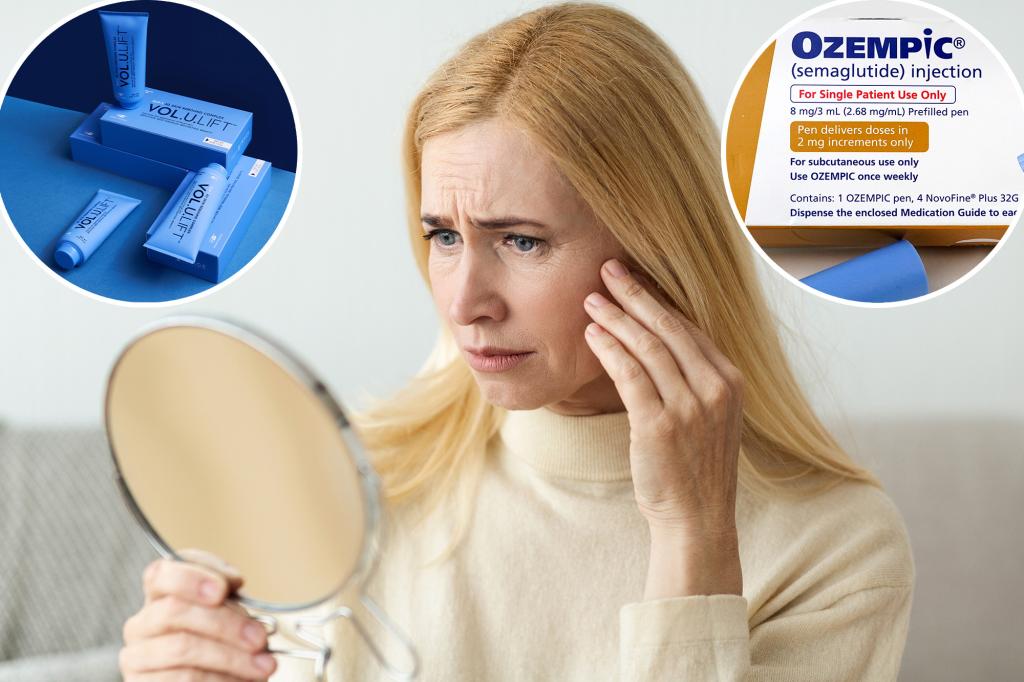You wanted a tighter waistline — and ended up with a looser face.
As Ozempic and other GLP-1 weight-loss medications skyrocket in popularity, one unflattering side effect is earning quite a bit of attention: “Ozempic face,” the gaunt, prematurely aged look some patients develop after shedding pounds at record speed.
Now, the skincare industry is rushing to keep up — and a new treatment has emerged specifically designed to counteract the deflated cheeks, deep wrinkles and sagging skin that follow fast weight loss.
Why does Ozempic face happen?
The reason some people on these drugs can sometimes look much older after weight loss isn’t actually because of the drug itself — it’s the speedy slim down that does it.
“Patients on GLP-1 medications such as Ozempic often experience rapid weight loss, which leads to noticeable changes in facial skin such as deflation, deep wrinkles, dehydration and density loss,” plastic surgeon Dr. Marc Ronert told The Post.
“When fat and muscle volume drop quickly, the skin can’t always bounce back, leading to a prematurely aged appearance.
“These skin changes are not unique to Ozempic. Anyone who’s lost weight quickly can experience facial deflation, which causes skin aging.”
The new Ozempic support market
But as millions of Americans turn to these medications, an entire market is emerging to support the skin, hair and hormonal side effects of fast-track weight loss.
A new daily supplement designed to combat “Ozempic face” hit shelves late last year, while analysts predict we’re only seeing the beginning of this trend.
“Brands can better serve these consumers by focusing on solutions that enhance skin elasticity and firmness,” Lindsay Cameron, a health and wellness analyst at Mintel, told Glossy.
“There’s a promising opportunity for beauty and personal care brands to tackle issues like loose skin, premature aging and hair loss, which frequently accompany rapid weight loss, despite users’ nutritional and supplemental efforts.”
Slim down skincare
That’s why Ronert recently launched VOL.U.LIFT, a product he created specifically to counteract the dreaded Ozempic face.
“We identified four main facial concerns that accompany GLP-1 treatments: accelerated volume loss and sagging, density loss, dehydration and wrinkles,” Ronert said.
While developing it, they “conducted extensive clinical studies to understand how these medications directly impact skin. Each ingredient was handselected to address these very specific facial changes.”
Some of those ingredients include L-ornithine amino acid, which “has been shown to increase fatty tissue volume and visibly plump the skin,” and bakuchiol, which “reduces lines and wrinkles and improves the appearance of skin firmness and texture quality.”
It’s also made with plant collagen fragments to improve hat “deflated” look and even kangaroo paw extract — yes, you read that right.
“Kangaroo paw extract helps to visibly firm skin, reducing the appearance of sagging,” he explained.
Its secret sauce is a smart encapsulation technology called XOSM, which Ronert says “delivers powerful antioxidants into skin to amplify firming and lifting effects.”
But though Ronert boasted that his treatment is the first of its kind, he thinks the industry will only grow.
“We’re witnessing a major cultural shift in how people approach weight loss, and that’s creating a new set of needs in skincare,” he said.
“I believe it’s just the beginning of a new category that crosses over between beauty and health — one where skincare and metabolic medicine intersect in a powerful way.”
More drastic measures
While skincare might help, some are going deeper, with growing demand for cosmetic procedures to correct the sunken, saggy look.
“In younger patients and more mild cases where the skin elasticity remains reasonably strong, fillers tend to work better,” Dr. Patrick Byrne, president of the American Academy of Facial Plastic and Reconstructive Surgery, previously told The Post.
He named hyaluronic acid as the top choice because “it’s a naturally occurring substance within the skin and soft tissues, so there’s really no meaningful risk of rejection or reaction” and, crucially, “it’s reversible.”
Other options include laser resurfacing, ultrasound devices and — in the most extreme cases — going under the knife.
“With a lot of volume loss, especially when the skin elasticity has declined, surgical options tend to be most effective,” Byrne said, noting that the most popular procedures include full face and neck lifts — plus lower eyelid surgery to tackle the toll of rapid weight loss.
Read the full article here


